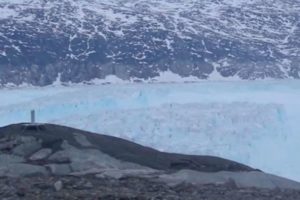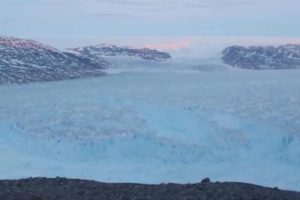
Four Mile Long Iceberg Calves Out From A Greenland Glacier, Scientists Capture The Moment
Scientists successfully captured the precious moment of a four-mile long iceberg broke off a glacier in eastern Greenland.

The incident of calving occurred on June 22 in which an iceberg of the size of about a third of the length of Manhattan broke off the glacier.
The team comprising researchers and scientists at the site captured the precious moment of the event the result of which was that it caused other icebergs to separate with some flipping over entirely.

The entire event was captured on a camera that can help scientists examine how large icebergs may affect future sea levels.
David Holland, a professor at NYU’s Courant Institute of Mathematics and NYU Abu Dhabi, who led the research team, said: “Global sea-level rise is both undeniable and consequential”.
“By capturing how it unfolds, we can see, first-hand, its breath-taking significance,” he added.
The event of calving began at 11.30 pm on June 22 that a four-mile long iceberg begins to splinter off the Helheim Glacier.
The event took just 30 minutes for the iceberg to completely detach from the Glacier and the researchers condensed the whole event in a minute and a half long clip.
The clip displays the giant iceberg breaking off and then slowly drifting into the sea.
The filming was done by Denise Holland who said: “Knowing how and in what ways icebergs calve is important for simulations because they ultimately determine global sea-level rise.”
“The better we understand what’s going on means we can create more accurate simulations to help predict and plan for climate change.”
NYU’s experts said that a tabular iceberg, meaning that it was a wide and flat one.
As the iceberg broke away from the glacier, other icebergs are known as pinnacle bergs meaning they are tall and thin and easily splinter off as well and flip over.
The film footage shows the iceberg crashing into another iceberg as it floats down the fjord before it begins to split in two.
Scientists are as of now busy doing research about how the melting ice sheets could at last affect sea levels around the world as the global temperatures continue to rise.
Holland added: “The range of these different iceberg formation styles helps us build better computer models for stimulating and modeling iceberg calving.”
You May Also Read: NASA Working To Return To The Moon, But To Stay There
